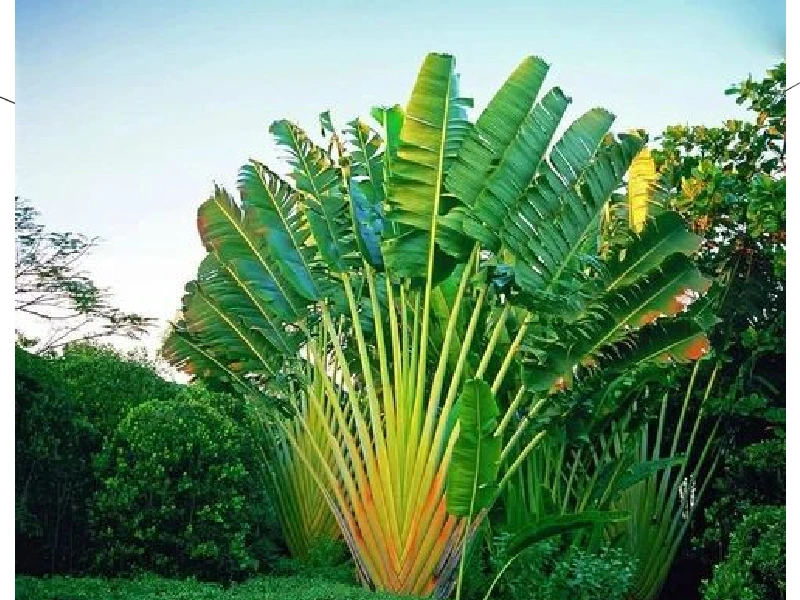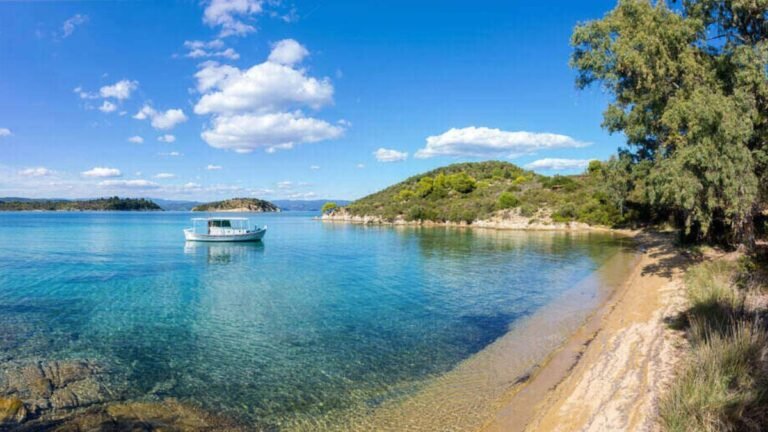
If you’ve ever spotted a majestic tree with fan-shaped leaves stretching toward the sky like a giant green compass, you’ve already met the traveler’s palm. Known for its striking beauty and fascinating history, this tropical marvel isn’t a true palm at all but a distant relative of the bird of paradise. Its story blends science, symbolism, and sheer natural elegance. Let’s explore everything you need to know about this incredible plant, from its origins to growing tips and cultural meaning.
What Is a Traveler’s Palm?
Despite its name, the traveler’s palm (Ravenala madagascariensis) isn’t part of the palm family. It belongs to the Strelitziaceae family, the same one as the famous bird of paradise. Native to Madagascar, it’s often called the traveler’s tree or Madagascar fan plant. The name comes from its huge fan of paddle-shaped leaves that resemble a palm, though its biology tells another story.
Key Characteristics
-
Height: Can reach up to 30 feet (9 meters) tall
-
Leaves: Large, banana-like leaves arranged in a perfect east–west fan
-
Flowers: White, bird-like blooms emerging from thick green sheaths
-
Trunk: Smooth and greyish-green with leaf scars forming neat rings
This unique fan formation isn’t just beautiful—it’s also nature’s design at work. The leaves collect rainwater, which gathers in the leaf bases, earning it the nickname “the traveler’s friend.”
Traveler’s Palm vs. True Palm Trees
| Feature | Traveler’s Palm | True Palm |
|---|---|---|
| Scientific Family | Strelitziaceae | Arecaceae |
| Origin | Madagascar | Worldwide Tropics |
| Leaf Shape | Paddle-shaped, fan formation | Feathered or fan-like |
| Trunk Structure | Single, smooth trunk | Clustered or rough trunk |
| Flowers | White, bird-like | Various types |
| Water Storage | Yes | No |
This table clears up a common misconception: while it looks like a palm, the traveler’s palm is closer to a banana plant than to a coconut palm.
The Fascinating History and Symbolism of the Traveler’s Palm
The traveler’s palm carries both practical and spiritual meaning. Ancient travelers in Madagascar and other tropical regions noticed that water collected in the leaf bases—often enough to quench thirst in emergencies. That’s how it earned its name as the tree that helps travelers survive.
Cultural and Spiritual Symbolism
-
Guidance: Its east–west leaf alignment was said to help travelers find their direction.
-
Protection: Villagers believed the plant shielded them from misfortune.
-
Resilience: It thrives even in tough tropical climates, symbolizing endurance and balance.
An old Malagasy legend says the plant was blessed by nature to serve as a compass and water source for those who lost their way. It’s no surprise many cultures view the traveler’s tree as a symbol of hope and safe passage.
How to Identify a Traveler’s Palm
You can recognize a traveler’s palm almost instantly by its spectacular fan of leaves, which look like a giant peacock’s tail frozen in motion. Each leaf can reach up to 10 feet long, radiating out symmetrically.
Distinctive Features
-
Fan Shape: Perfectly aligned east to west.
-
Leaves: Paddle-shaped and leathery.
-
Flowers: Large, white, and bird-like.
-
Seeds: Encased in vivid blue pods, adding ornamental value.
Below is a simple diagram-style description:
🌿 Fan Leaves (East-West Orientation)
│
│ ──── Central Trunk
│
🌱 Root Base
The plant’s symmetry isn’t just eye-catching—it helps it capture maximum sunlight for photosynthesis while withstanding tropical winds.
Growing and Caring for a Traveler’s Palm
Ideal Growing Conditions
The traveler palm flourishes in tropical and subtropical climates. It loves sunshine, moisture, and fertile soil.
Best Conditions:
-
Sunlight: Full sun to partial shade
-
Soil: Rich, well-drained, and slightly acidic
-
Temperature: Prefers 70°F–90°F (21°C–32°C)
-
Humidity: High humidity boosts leaf growth
-
Watering: Deeply water 2–3 times per week
Planting and Propagation
You can grow traveler’s palm from either seeds or division (splitting off young shoots).
Steps to Plant:
-
Choose a sunny, wind-protected location.
-
Dig a hole twice the size of the root ball.
-
Mix organic compost with the native soil.
-
Plant the palm upright, ensuring the base is level with the ground.
-
Water deeply and mulch around the base to retain moisture.
Avoid overwatering—soggy soil leads to root rot. It’s also wise to leave enough space (at least 10 feet) between plants, as mature palms can spread wide.
Fertilizing and Pruning Tips
-
Fertilizer: Use a balanced tropical fertilizer (10-10-10) every 2–3 months.
-
Pruning: Remove dead or yellowing leaves to keep the fan clean and healthy.
-
Tip: Never cut into the central growth stem—it may stop new leaves from forming.
Common Problems and Pests
Like most tropical plants, traveler’s palms attract certain pests and diseases.
| Problem | Cause | Solution |
|---|---|---|
| Yellow Leaves | Overwatering or poor drainage | Reduce watering, improve soil |
| Spider Mites / Mealybugs | Dry conditions | Spray neem oil or insecticidal soap |
| Fungal Root Rot | Constantly wet soil | Improve drainage, apply fungicide |
Keeping the soil slightly moist—not soggy—is the golden rule.
Landscape and Indoor Uses of the Traveler’s Palm
This plant is an architectural masterpiece in tropical landscaping. Its massive fan and glossy green leaves make it a natural centerpiece for gardens, hotels, and resorts.
Landscape Design Ideas
-
Use as a focal point near entryways or water features.
-
Plant in rows to form natural green walls.
-
Pair with banana trees, heliconias, or coconut palms for a layered tropical look.
Indoor or Patio Use
While it’s challenging to grow indoors due to its size, dwarf varieties thrive in large atriums or conservatories with bright light and humidity.
“The traveler’s palm doesn’t just grow—it performs,” says tropical landscape designer Maria Santos. “Its symmetry brings order to the chaos of nature.”
Environmental and Practical Benefits
Beyond aesthetics, the traveler’s palm contributes to the ecosystem in multiple ways:
-
Shade Provider: Its broad leaves offer natural shade in hot climates.
-
Water Source: Stores rainwater at its base, supporting small wildlife.
-
Air Purifier: Like many tropical plants, it improves air quality by filtering pollutants.
-
Cooling Effect: Acts as a natural coolant for surrounding environments.
In rural Madagascar, people have historically used its leaves for roof thatching, food wrapping, and temporary shelter—proof that this tree has served humans for generations.
Traveler’s Palm in Modern Culture
From resort entrances to luxury garden landscapes, traveler palms have become a symbol of tropical elegance and relaxation. They often appear in:
-
Hotel and spa designs for their symmetrical appeal.
-
Travel photography as exotic backdrops.
-
Brand logos for eco-lodges and travel agencies.
It’s the plant that whispers, “You’ve arrived in paradise.”
Where to Buy Traveler’s Palm Plants or Seeds
If you’re ready to add this tropical gem to your collection, you can find traveler’s palm plants or seeds online.
Recommended Sources:
Average Price Range:
| Size | Price | Availability |
|---|---|---|
| Small (1–2 ft) | $25–$45 | Widely available |
| Medium (3–5 ft) | $60–$90 | Limited stock |
| Large (6+ ft) | $100+ | Pre-order or local nurseries |
Always check the seller’s location and shipping policy—traveler’s palms don’t tolerate long exposure to cold during transport.
Traveler’s Palm vs. Similar Species
| Species | Common Name | Key Difference |
|---|---|---|
| Ravenala madagascariensis | Traveler’s Palm | Fan-shaped leaves, Madagascar origin |
| Strelitzia reginae | Bird of Paradise | Smaller, orange-blue flowers |
| Cocos nucifera | Coconut Palm | True palm, produces coconuts |
Many gardeners confuse the traveler’s palm with the bird of paradise, but while they share ancestry, the traveler’s palm is much taller and less flower-focused.
Fun Facts About the Traveler’s Palm
-
The leaves always face east–west, earning it the title “Nature’s Compass.”
-
A mature plant can store up to one liter of water in its leaf bases.
-
It can grow more than 30 feet tall under ideal conditions.
-
Seeds are bright blue—an unusual trait among tropical plants.
-
Its fan structure has inspired architectural designs in eco-resorts worldwide.
Final Thoughts: Why Every Traveler Should Know the Traveler’s Palm
The traveler’s palm is more than a tropical ornament—it’s a living symbol of guidance, endurance, and beauty. Whether you’re a gardener seeking an exotic centerpiece or a traveler chasing natural wonders, this tree tells a timeless story. It reminds you to stay curious, stay grounded, and keep moving toward the sun—just like its leaves always do.


